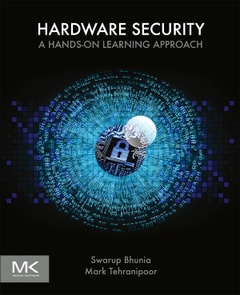Hardware Security A Hands-On Learning Approach
Auteurs : Bhunia Swarup, Tehranipoor Mark

Hardware Security: A Hands-On Learning Approach provides a broad, comprehensive, and practical overview of hardware security encompassing all levels of our electronic hardware infrastructure. It covers basic concepts through advanced attack techniques and countermeasures, as illustrated through theory, case studies, and well-designed hands-on laboratory exercises for each key concept. The book is primarily intended to serve as a textbook for upper-level undergraduate students studying computer engineering, computer science, electrical engineering, and biomedical engineering, as well as a handy reference for graduate students, researchers and industry professionals.
For academic courses, the book contains a robust suite of teaching ancillaries, including:
- Schematic, layout and design files for a printed circuit board for hardware hacking (i.e. the HaHa board) that can be used by instructors to fabricate boards and provide to students for hands-on experiments
- A suite of videos demonstrating different hardware vulnerabilities, hardware attacks and countermeasures (downloadable from Elsevier website)
- Register transfer level (RTL) hardware code for AES to implement side-channel attacks (downloadable from Elsevier website)
Detailed description and user manual for the companion material
- Provides a thorough overview of computer hardware including fundamentals of computer systems and the implications of security risks therein, studies of known and proposed attack methodologies and countermeasures, case studies, and laboratory exercises to train students on key security issues at each level of hardware abstraction
- Includes discussion of the liability, safety, and privacy implications of hardware and software security and interaction among them, topics often overlooked in the overall spectrum of cybersecurity
- Gives insight into a wide range of security and trust issues and solutions including emerging attacks and protection mechanisms in the electronic hardware life cycle from design, fabrication, test, distribution through supply chain to deployment in the field
1. Introduction to Hardware Security
Part I: Electronic Hardware (ASIC, FPGA, PCBs) 2. Background on Electronic Hardware 3. System-on-Chip (S0C) Design and Test 4. Printed Circuit Boards (PCBs) Design and Test
Part II: HARDWARE ATTACKS: ANALYSIS, EXAMPLES & THREAT MODELS 5. Hardware Trojan Horse 6. Hardware Supply Chain Issues 7. Hardware IP Piracy and IP Reverse Engineering 8. Side-Channel Attacks (SCA) 9. Scan-based Attacks, JTAG Hacks and DMA Attacks 10. IC Microprobing Attacks and IC Reverse Engineering 11. Attacks on PCB – Snooping, Counterfeiting, Reverse Engineering and Piracy, Physical Attacks
Part III: COUNTERMEASURES AGAINST HARDWARE ATTACKS 12. Hardware Security Primitives 13. Design for Security (DfS) and Security/Trust Validation for Integrated Circuits 14. Hardware Obfuscation 15. PCB Integrity Validation and Authentication
Part IV: EMERGING TRENDS IN HARDWARE ATTACKS AND PROTECTIONS 16. Joint Hardware-Software Attacks and Countermeasures 17. Summary and Future Directions
Appendix: Suggested practices for "secure digital design"
Upper-level engineering undergraduate students with majors in computer engineering, computer science, electrical engineering, and biomedical engineering
Mark Tehranipoor is currently the Intel Charles E. Young Professor in Cybersecurity at the Department of Electrical and Computer Engineering (ECE), University of Florida. Prof. Tehranipoor has published over 300 journal articles and refereed conference papers and has given more than 150 invited talks and keynote addresses since 2006. In addition, he has published six books and ten book chapters. His projects are sponsored by both industry (Semiconductor Research Corporation (SRC), Texas Instruments, Freescale, Comcast, Honeywell, LSI, Mentor Graphics, Juniper, R3Logic, Cisco, Qualcomm, MediaTeck, etc.) and the US Government (NSF, ARO, MDA, DOD, AFOSR, DO
- Provides a thorough overview of computer hardware, including the fundamentals of computer systems and the implications of security risks
- Includes discussion of the liability, safety and privacy implications of hardware and software security and interaction
- Gives insights on a wide range of security, trust issues and emerging attacks and protection mechanisms in the electronic hardware lifecycle, from design, fabrication, test, and distribution, straight through to supply chain and deployment in the field
- A full range of instructor and student support materials can be found on the authors' own website for the book: http://hwsecuritybook.org
Date de parution : 11-2018
Ouvrage de 432 p.
19x23.4 cm
Disponible chez l'éditeur (délai d'approvisionnement : 14 jours).
Prix indicatif 92,73 €
Ajouter au panierThèmes de Hardware Security :
Mots-clés :
3PIP; 3rd Party IP; ASICs; Assistive technologies; Benchmarks; Bitstream Obfuscation; Circuit Theory; Counterfeits; Design for Anticounterfeit (DfAC); Design-for-Debug; Design-for-Testability; Digital Logic; Embedded Systems; Encryption; Fault Injection; FPGAs; Hardware Obfuscation; Hardware Trojan; Human computer interactions; Human machine interface; IC Recycling and Cloning; Integrated Circuit (IC) Overproduction; Intellectual Property (IP) Overuse; IP Piracy; IP Reuse; JTAG Attacks; Machine



